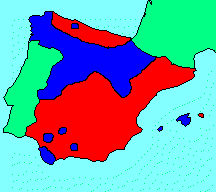
Throughout Morocco and Spain military garrisons (aided, in places, by the Guardia Civil and the Falange) rose in revolt against the Republican Government.
The Insurgents (or Nationalists) succeeded in seizing power in Morocco, Navarre, Galicia, Old Castile and Seville, but were thwarted in the key cities of Barcelona and Madrid.
Santiago Casares Quiroga (of the Left Republican Party) resigned from the post of Prime Minister of the Republic. President Manuel Azana asked Diego Martinez Barrio (a member of the Republican Union Party) to form a moderate government that could negotiate with the rebels. When Barrio was unable to form a government that enjoyed any real support he resigned. Professor Jose Giral (of the Republican Party) replaced him and ordered that arms be distributed to the workers.
General Francisco Franco flew from Tenerife to Tetuan to take over command of the Army of Africa.
Prime Minister Giral appealed to the French Socialist Government (whose Prime Minister was Leon Blum) for arms supplies.
General Francisco Franco sent emissaries to Hitler and Mussolini to ask for military aid and technical assistance.
The nominal leader of the Rising, General Jose Sanjurjo, was killed when the aircraft bringing him from Portugal to Burgos crashed on take-off.
When it became apparent that the Rising in Madrid had failed, the Nationalist supporters in Toledo, which is 40 miles to the Southwest of the capital, occupied the Military Academy in the Alcazar fortress. The garrison was mainly drawn from the local Guardia Civil and Falange, and was commanded by the Commandant of the Academy, Colonel Jose Moscardo. For two months the defenders held out against the Republican Militia units besieging them; they were finally relieved when troops from the Army of Africa, led by Colonel Jose Varela, stormed Toledo. The raising of the siege of the Alcazar did much to enhance General Franco's reputation, but the diversion of Varela's troops from the advance on Madrid gave the capital's defenders further time to prepare their defences.
El Ferrol, the main naval base in the Northwest of Spain, surrendered to the Nationalists. As a result the Nationalists acquired a battleship, Espana, two cruisers, Republica and Almirante Cervera (with another two, Baleares and Canarias, under construction), and a destroyer, Velasco.
The Nationalists captured Alto de Leon to the Northwest of Madrid.
The Committee of National Defence (the Nationalist Government) met for the first time in Burgos.
The Nationalists captured the Somosierra Pass to the North of Madrid.
The first shipment of French aircraft sent as aid to the Republican Government arrived in Spain.
The COMINTERN agreed to send volunteers and funds to aid the Republic.
Adolf Hitler agreed to send military aid to the Nationalists after negotiating with representatives sent to Berlin by General Franco.
The airlift, which was to carry the Army of Africa from Morocco to the Mainland, began when German and Italian transport aircraft arrived in Spain's North African territories.

The Nationalists began an offensive in Estremadura.
The French Government changed its attitude towards Republican Spain and stopped further sales of arms and ammunition. This marked the beginning of the Non-Intervention Policy.
The Nationalist gunboat Eduardo Dato was sunk at Algerciras by the Republican battleship Jaime I.
The Republican battleship Jaime I was damaged by a Nationalist air attack off the coast at Malaga.
Nationalist forces, drawn from the Army of Africa and led by Colonel Juan Yague, captured Badajoz. The two parts of Nationalist Spain were now linked.
On 9th August a Republican expeditionary force of Catalan and Valencian troops, commanded by Air Force Captain Alberto Bayo and Guardia Civil Captain Manuel Uribarri, landed on Ibiza. With the help of local people the expeditionary force quickly overcame the Nationalist garrison, and the island returned to Republican control. Seven days later, at dawn on 16th August, the Catalan troops, led by Captain Bayo, landed on Majorca, and by the evening they had advanced eight miles inland from their landing place at Porto Cristo. The Nationalist garrison on Majorca was commanded by Colonel Garcia Ruiz and proved to be much stronger than that on Ibiza. With the help of Italian fighter aircraft and bombers the Nationalists were able to contain any further Republican advance, and on 3rd September they mounted a counter-attack on the Republican bridgehead. The Catalan troops rapidly withdrew to the beaches and re-embarked aboard the ships that had brought them whilst under cover of the guns of the battleship Jaime I.
The new Russian Ambassador, Marcel Rosenberg, arrived in Republican Spain. He was accompanied by a large number of Russian "advisers".
The Nationalists bombed Madrid for the first time.
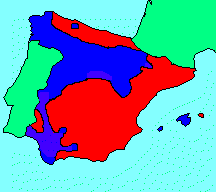
The Nationalists captured Talavera de la Reina.
Francisco Largo Caballero (the leader of the Socialists) became Prime Minister. His Government was a coalition of Socialists, Communists and Left Republicans.
The Nationalists closed the border between the Basque Provinces and France when Irun was captured by troops led by Colonel Alfonso Beorlegui.
Italian aircraft arrived in Majorca and set up bases from which to bomb the Republic.
The first autonomous Basque Government, led by Jose Antonio Aguirre, was formed.
The Non-Intervention Committee met for the first time in London.
The Nationalists captured San Sebastian.
The Nationalists captured Ronda.
The Republican submarine B6 was sunk by Nationalist naval forces, led by the destroyer Velasco, off Cape Penas near Santander.
The Republican destroyer Almirante Juan Ferrandiz was sunk by the Nationalist cruiser Canarias during a naval battle off the coast near Gibraltar.
General Franco was proclaimed Commander-in-Chief (Generalissimo) and Head of State in Burgos.
The Republican Government approved the Statute giving autonomy to the Basque Provinces. Jose Antonio Aguirre became the first President of the new Basque State, Euzkadi.
The Republican Government announced the creation of the Popular Army. This was to incorporate both the Army units that had remained loyal to the Government and the Party Militias.
The first Russian aid for the Republic arrived.
The Republican submarine B5 was sunk by Nationalist aircraft off the coast near Malaga.
The Popular Army established a system of Commissars (Political officers) for each unit.
A large part of Spain's Gold Reserve (which remained in Republican controlled Spain after the Rising) was transferred to Russia. This was to pay for Russian "aid".
Russian tanks and aircraft appeared in the front-line for the first time.
German and Italian bombers began a series of raids on Madrid in the hope of destroying civilian resistance.
The Nationalists captured Brunete.
The Nationalists captured Getafe.
Russian fighter aircraft appeared for the first time in the skies over Madrid.
Because they expected Madrid to fall at any moment to the Nationalists, the Republican Government moved to Valencia. A Defence Junta, under the leadership of General Jose Miaja, was established to organise the last-ditch defence of Madrid.
The Nationalists were now poised to make an all-out attack on Madrid in the hope of capturing the Spanish capital and thus ending the war. The forces at their disposal were led by General Emilio Mola and the majority of them were units of the Army of Africa. Mola ordered Colonel Jose Varela to attack the north-west flank of Madrid's defences, and by 16th November Varela's troops had forced a bridgehead over the River Manzanares. During the following week almost three-quarters of the University City fell to the Nationalists, but the poorly armed militia units that comprised the Popular Army, led by General Jose Miaja and aided by Russian tanks and aircraft, stemmed the Nationalist advance. Further assistance to the Republican cause came from the first International Brigade units to reach the front-line. It is worth noting that the XIth Brigade, which was mostly composed of German, Polish and French volunteers, arrived after the front-line had stabilised. By 23rd November both sides were exhausted by the fighting and began digging in. Varela had failed to achieve the desired break-through. Although the Nationalists held the areas to the North and West of the city, it was obvious that all further frontal attacks upon Madrid would be costly and likely to fail.
The German Condor Legion went into action for the first time. The air attacks were made in support of further Nationalist attempts to capture Madrid.
Italy and Germany recognised General Franco's government.
Buenaventura Durruti (a leading figure in the Anarchist movement) was wounded in the front-line at Madrid. He died the next day.
Jose Antonio Primo de Rivera (the leader of the Falange), who had been stranded in Republican Spain at the time of the Rising, was executed in Alicante.
Nationalist aircraft bombed Barcelona.
As the frontal attack upon Madrid had failed, the Nationalists now tried to tighten the siege and to cut off the capital from the rest of Republican Spain. On 13th December General Jose Varela launched an offensive towards the Corunna Road, which runs 25 miles to the North of Madrid. Between 3rd and 15th January his forces held a 7 mile stretch of the road against fierce attacks by Republican troops but, as casualties mounted on both sides, it became apparent that the situation had become a stalemate.
The POUM (Partido Obrero de Unification Marxista [Revolutionary (i.e. anti-Stalinist) Communists]) was ousted from the Generalitat (Catalan Government) by the Communists.
The Republican submarine C3 was sunk by an Italian submarine off the coast at Malaga.
The first Italian "volunteers" arrived in Cadiz to aid the Nationalists.
The Council of Aragon, which was dominated by the CNT (Confederacion Nacional de Trabajo [the Anarcho-Syndicalist Trades Union]), was recognised by the Republican government.
With the arrival in Spain of the Italian "volunteers" the Nationalists now felt able to mount an offensive on the southern provinces of Republican Spain. Three Nationalist columns converged on Malaga; the Army of the South, led by General Gonzalo Quiepo de Llano, advanced from the West; from Granada, to the north-east of the city, came forces under the command of Colonel Antonio Munoz; and moving down from the North were the Italians, led by General Mario Roatta. Although large numbers of Republican troops were available to defend Malaga, they were badly organised and they steadily retreated. By 3rd February the attackers had reached the outskirts of the city and, three days later, when the last defenders fled northward towards Almeria, the Nationalists entered Malaga.
The Nationalists renewed their attempts to capture Madrid. This time they concentrated their efforts upon cutting the Valencia Road where it runs through the Jarama Valley to the south-east of the city. The Nationalists, under the leadership of General Luis Orgaz, began their assault on 6th February and, by 11th February, they had driven the Republican army, commanded by General Sebastian Pozas, eastwards across the River Jarama. To restore the situation General Jose Miaja took over personal command of the dispirited Republican troops on 15th February. By 24th February, when the fighting finally ended, the Nationalists had driven a salient into the Republican front-line but had failed again to cut Madrid off from the rest of the Republic.
The Nationalist forces threatening Madrid were ordered to attack around the north-east of the city in an attempt to cut it off from the rest of the Republic. Two Nationalist armies advanced towards Guadalajara, which is 34 miles from Madrid, and pushed back the inexperienced Republican troops that faced them. The right-hand (or western) army, which was commanded by General Jose Moscardo, had little trouble in forcing the opposing Republican troops back, but the left-hand (or eastern) army, which was composed of Italian "volunteers" and led by General Mario Roatta, experienced stiffening resistance after their capture of Brihuega on 10th March. General Roatta halted his advance on 15th March to re-group and the Republicans used this break in the battle to mount a counter-attack. Two divisions, assisted by Russian tanks and aircraft and led by Colonel Enrique Jurado, fell on the leading Italian units on 18th March. The ferocity of the counter-attack surprised the Italians and their retreat rapidly became a rout. Moscardo's army was forced to fall back because of the Italian collapse and the Republic recaptured Brihuega. Although the Nationalist attack had gained some ground when the battle finally ended, it had failed to achieve the decisive result that had been hoped for.
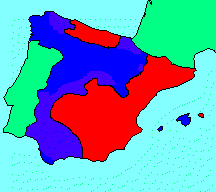
The Nationalists forces in the North, led by General Emilio Mola, began an offensive against Basque forces in Vizcaya with the intention of capturing the Basque stronghold of Bilbao. The Basques, who were not well armed and who were led by General Francisco Llano de la Encomienda, gave ground, and the towns of Durango and Guernica surrendered on 28th April after suffering heavy bombing by units of the German Condor Legion. After the death of General Mola in an air crash on 3rd June, General Fidel Davila took command of the Nationalist forces. By 11th June the Basques had withdrawn behind the "Ring of Iron" defences around Bilbao, but these proved to be less than effective when subjected to heavy artillery bombardment. Under cover of the bombardment the Nationalists breached the outer defences and the "Ring of Iron" collapsed. On the night of 13th June most of the civilian inhabitants of Bilbao were evacuated, and on 18th June the last units of the Basque army, now led by General Mariano Gamir Ulibarri, abandoned the city. The Nationalists entered Bilbao on the next day.
The Falange and Carlists Movement were united and became the FET (Falange Espanola Tradicionalista y de las Junta de Ofensiva Nacional-Sindicalista).
The Madrid Defence Junta was dissolved.
During the blockade of Bilbao, the Nationalist battleship Espana hit a mine and sank off Cape Penas near Santander.
Street-fighting broke out in Barcelona; the CNT (Confederacion Nacional de Trabajo [the Anarcho-Syndicalist Trades Union]) and POUM battled with the Communists supported by the Generalitat.
The Nationalist motor torpedo boat Javier Quiroga sank off Gibraltar.
Largo Caballero resigned as Prime Minister.
After the resignation of Largo Caballero, Dr Juan Negrin (a Socialist) became Prime Minister. The new Government was dominated by Communists.
The Republicans began an offensive to capture Segovia. Three Republican Divisions, under the command of General Domingo Moriones, broke through the Nationalist front-line at San Ildefonso and captured La Granja. Nationalist troops, led by General Jose Varela, were detached from the Madrid front and used to mount a counter-attack that stopped any further Republican advance.
The POUM was outlawed and its leaders were arrested.
The Republican battleship Jaime I blew up and sank at Cartagena.
The Nationalist motor torpedo boat Falange sank.
Andres Nin (leader of the POUM) was murdered by Soviet agents.
After the failure of the Nationalist attack upon Guadalajara the Republican troops around Madrid went on to the offensive. General Jose Miaja ordered two Republican Corps (led by Generals Juan Modesto and Enrique Jurado) to advance southwards from the El Escorial - Madrid road towards Brunete. This would then cut off the Nationalist forces besieging Madrid from the West. Their initial thrust captured Brunete and drove a 5 mile salient into the Nationalist front-line. The Nationalist armies, under the command of General Jose Varela, then rallied and mounted a counter-attack that forced the Republicans almost all the way back to their start line.
The Council of Aragon was dissolved by the Republican government.
After capturing Bilbao, the Nationalist forces in the North of Spain switched their offensive towards Santander. The Nationalists, who were led by General Fidel Davila, advanced westwards through the Cantabrian Mountains. Despite the large numbers of troops General Mariano Gamir had under his command, Republican resistance was weak. This weakness was due, in the main, to poor training and a shortage of weapons. On 23rd August the Basque forces in the Republican army surrendered to General Ettore Bastico, and because further resistance was impossible, Ulibarri abandoned his remaining troops and flew to safety in France. The Nationalists were then able to enter Santander almost unopposed.
A new political police force, the SIM (Servicio Investigacion Militar), was formed in Republican Spain. It was controlled by the Communists and contained many Russian "advisers".
The Republican Army of the East, led by General Sebastian Pozas, advanced into Aragon from Catalonia to capture Saragossa. They pushed back the Nationalist forces (which were commanded by General Miguel Ponte) to the North and South of the River Ebro, but were unable to dislodge them from the area around Saragossa or to capture Huesca (in the North) or Teruel (in the South). By the end of September the offensive had ceased to have any impetus and had come to a halt.
After the capture of Bilbao and Santander the only remaining Republican stronghold in the North was Gijon and the surrounding area. The Nationalists, who were led by Generals Antonio Aranda and Jose Solchaga, launched an offensive through the Mountains of Leon and along the coast from the East to capture Gijon. Aranda's forces were unable to break through the mountain passes, which were defended by Asturian troops, until a Navarrese force, under Solchaga's command, captured the village of Infiesto. This out-flanked the defences and the Asturians were forced to retreat. On 21st October Gijon surrendered and the whole northern coast of Spain now passed into Nationalist control.
Largo Caballero was removed from the leadership of the UGT (Union General de Trabajadores [Socialist Trades Union]).
The Republican submarine C6 was scuttled at Gijon after suffering damage during a Nationalist air attack.
The Republican destroyer Ciscar was sunk at Gijon by Nationalist aircraft.
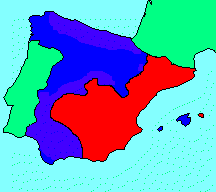
The Republican Government moved from Valencia to Barcelona.
The Republican Army launched an offensive to capture Teruel to pre-empt a Nationalist attack upon Catalonia. Two Republican armies (led by Generals Hernandez Sarabia and Leopoldo Menendez) advanced on Teruel and by nightfall on 15th December they had surrounded the city. The garrison, which was commanded by Colonel Rey d'Harcourt, held out in the southern part of the city until 8th January; casualties and lack of supplies then forced them to surrender. On 29th December General Franco had ordered Generals Jose Varela and Antonio Aranda to mount a counter-attack to relieve the defenders but the appalling winter weather hampered their advance and d'Harcourt had surrendered before they could raise the siege. The Republicans now found that they were in danger of being besieged in Teruel themselves. On 7th February Nationalist cavalry attacked the Republican forces to the North of the city and forced them to retreat and by 17th February Moroccan troops (led by General Juan Yague) had crossed the River Alfambra. Three days later the Nationalists had almost surrounded the city and the Republican armies were forced to retreat along the Valencia road to the south-east. The Nationalists then reoccupied Teruel.
The modern Nationalist cruiser Baleares, which was escorting a convoy of merchant ships off the Mediterranean coast near Cartagena, was sunk by torpedoes launched by Republican destroyers.
With the failure of the Republican attack upon Teruel the Nationalists were now able to mount an offensive eastwards into on Aragon and Levante. The intention was to cut Republican Spain into two parts. The assault, which was led by General Fidel Davila, began on 9th March and by 16th March the Nationalists had forced the Republicans to retreat up to 60 miles in places. Lerida, in Catalonia, surrendered to the Nationalists on 3rd April, and twelve days later Vinaroz, a village about half-way between Valencia and Barcelona on the Mediterranean coast, was captured and the Republic was cut in two. The Nationalist sought to widen this gap and on 14th June they captured Castellon de la Plana, 40 miles North of Valencia. Republican resistance was, however, increasing, and the Nationalists brought the offensive to a halt to allow time for their troops to rest and re-equip before the attack on Valencia.
Barcelona was subjected to round-the-clock bombing by Italian aircraft based on Majorca.
Dr Negrin tried to sue for peace but General Franco demanded nothing less than unconditional surrender.
The Republican gunboat Laya was sunk by Nationalist aircraft at Valencia.
To relieve pressure on the Madrid defences and to divert Nationalist forces from their offensive towards Valencia, the Republic ordered General Juan Modesto to launch an offensive across the River Ebro. The attack, which was made by the newly formed Republican Army of the Ebro, forced the Nationalists, who were led by General Juan Yague, to retreat. In its initial phase the offensive was very successful, and on some parts of the front the attackers managed to advance up to 25 miles. The attack then began to lose impetus and the Republican forces began to dig in to await the Nationalist counter-attack. Superior use of air power and relentless attacks on the ground gradually forced the Republicans to retreat. This culminated, on 30th October, in a massive Nationalist attack and by 18th November the Republicans had been forced back across the River Ebro.
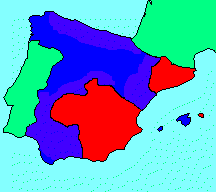
Dr Negrin announced, in a speech to the League of Nations, that the International Brigades were to be withdrawn from the fighting.
The International Brigades were withdrawn from the front-line prior to them being "repatriated".
The Republican submarine C1 was sunk by Nationalist aircraft at Barcelona.
The leaders of the POUM were put on trial in Barcelona. Two were acquitted but four were imprisoned.
The International Brigades paraded through Barcelona before they were disbanded.
Having cut the Republic into two the Nationalists now launched an offensive against Catalonia. The attack on the forces defending the Republican front-line was made by six Nationalist armies on a front that stretched from the Pyrenees to South of the River Ebro. It proved too much for the already exhausted Republicans. They retreated towards Barcelona and, once Borjas Blancas was captured on 4th January, the retreat became a rout. Tarragona surrendered on 14th January and by 24th January the Nationalists were within 3 miles of Barcelona. At this point the Government, led by Juan Negrin, fled to Gerona. The Republican troops in Barcelona continued to maintain a token resistance until 26th January, when the city finally surrendered.
The Republican destroyer Diez was damaged by the Nationalist cruiser Canarias off the coast near Catalon Bay. The Diez was so badly damaged that she had to be beached to stop her sinking. She was later towed to Gibraltar and remained there, interned, until the end of the war.
The Nationalists captured Gerona.
Manuel Azana resigned from the post of President of the Republic.
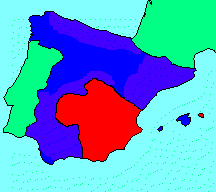
SPAIN - FEBRUARY 1939
The failure of Dr Negrin's Communist Government to sue for peace resulted in a civil-war-within-a-civil-war on the streets of Madrid. The National Defence Council, led by Colonel Casado, triumphed in the struggle for control of the Republic and tried to negotiate peace terms with General Franco. In the meantime Dr Negrin, his Cabinet, and Russian advisers flew out of Madrid to safety.
The Nationalists entered Madrid.
Hostilities ceased.
General Franco announced that the war was over.